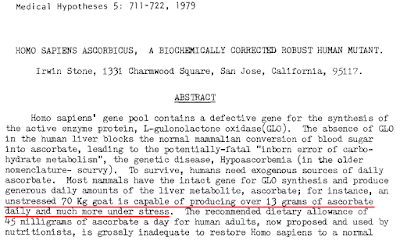 See what happens when a giant coconut crab is allowed unsupervised access to the Interducts? It reads on Alt-Med supplement-pimping websites that an unstressed 70-kilogram goat produces 13000 mg of Vitamin C in its liver per day, with more when stressed; and before you can say 'horsefeathers', it is stressing a goat to increase its production. Possession of a pet coconut crab brings supervisory responsibilities, and we are not well-pleased with the vile Throgmorton for his dereliction.
See what happens when a giant coconut crab is allowed unsupervised access to the Interducts? It reads on Alt-Med supplement-pimping websites that an unstressed 70-kilogram goat produces 13000 mg of Vitamin C in its liver per day, with more when stressed; and before you can say 'horsefeathers', it is stressing a goat to increase its production. Possession of a pet coconut crab brings supervisory responsibilities, and we are not well-pleased with the vile Throgmorton for his dereliction.I spent all morning soothing the traumatised goat, and then all afternoon trying to work out where the '13 grams' figure came from. For here at Riddled we are committed to bringing you readers the finest artisanal piffle and balderdash -- which is like pebbledash but with less hair -- and sometimes this means tender tendentiousness (freshly extracted and still a-gleam with rectal mucus), but sometimes it means vintage bafflegab, left to age for decades in great oaken casks to undergo the alchemy of time.
"13 grams" is a tenet of faith in the Alt-Med hive-mind, passed among the orthomolecular cranks and supplement shops in the manner of a second-hand lollipop. My research led me as far as the mutual-citation society of Stone and Linus Pauling in the late 1970s, and attribution can be narrowed down no further, for they were basically two buttocks of a single bum. Also Holford. Fortunately journamalists for the Independent are too hard-working and tough-minded to lazily regurge the bullshit they're fed YEAH RIGHT.
The wild goat, for instance, makes around 13,000mg a day, rising to 100,000mg when faced with life-threatening infectious or toxic stress, according to a 1961 study* published in the Annals of the New York Academy of Sciences.Now the details of animal husbandry and the pastoral economy are of little concern to members of the
Holford helpfully provides estimates for seven mammals -- all standardised to 70-kg members of their kind for ease of comparison (also, for simplicity, presumably spherical), all the better to dramatise the fallen 0-mg state of humankind -- and as the most productive species, goats became the canonical example of optimal ascorbate production. If cats had topped the chart, pill peddlers would blithely be bandying about factoids for 70-kg cats. Willingness to cite "70 kg" as the normal caprine weight sometime became a test of one's alt-med loyalty, and of fealty to Authorities rather than to common sense or real-world observation.
Vitamin C produced per day by different animal species
(equivalent for 70 Kg Man)
| Goat | 2,280 - 13,300 mg |
|---|---|
| Rat | 2,737 - 13,902 mg |
| Rabbit | 1,547 - 15,820 mg |
| Cow | 1,099 - 1,281 mg |
| Mouse | 2,352 - 19,250 mg |
| Sheep | 1,736 mg |
| Cat | 336 - 2,800 mg |
Meanwhile from Stone we learn of the Fall, when prosimian Adam and Eve lost their intrinsic enzymes for vitamin secretion, to be expelled from Ascorbic Eden despite consuming fruit in an attempt to disguise their lapsarian state.

Stone's Apocalyptic essay reads like an early draft of Stranger in a Strange Land. But it finishes on a happier note, with a radiant vision of restoration of health and happiness and Methuselan longevity with the help of "biological correction" i.e. genetic therapy (or failing that, through megadose dietary supplements).
The assertion that stress increases this imagined level of vitamin-C production is purely faith-based BECAUSE REASONS, with the advantage that unfettered by the surly bonds of evidence, Ascorbians are free to invent their own factor of increase. Pauling was wont to double it, but the factor expanded at each stage along the centipede, and now the long habit of repetition has established beyond cavil or doubt that a DIN-standard 70-kg goat in ISO Stress Position #6 will exude 100 grams of vitamin C daily.
Giacometti version
 Invertebrates e.g. crabs do not produce vitamin C at all, and suffer from chronic scurvy, which explains their craving for goat livers.
Invertebrates e.g. crabs do not produce vitamin C at all, and suffer from chronic scurvy, which explains their craving for goat livers.
----------------------
* The citation turns out to be to Conney et al., who made no claim even faintly resembling this. Here Jane Feinmann was acting as meat-puppet for pill-grifter Thomas Levy.






7 comments:
Invertebrates e.g. crabs do not produce vitamin C at all, and suffer from chronic scurvy, which explains their craving for goat livers.
==============
Glad we got that sorted. And thus global warming will lead to increased production of goats worldwide.
~
Now updated with predictably NSFW "animal husbandry" link.
Arrrrrr! Ye auld scurvy C goat! May thee suffer aPauling lack - at least until the 70Kg mouse is full grown.
Alternative title: Capricornicoepia.
Spidergoat, it's like Sleipnir got frisky with Tanngrisnir or Tanngnjóstr.
Uncle Smut! Where ya Beeee--eeee-eeeen?
:D
Where ya Beeee--eeee-eeeen?
Gutters, mainly.
Post a Comment